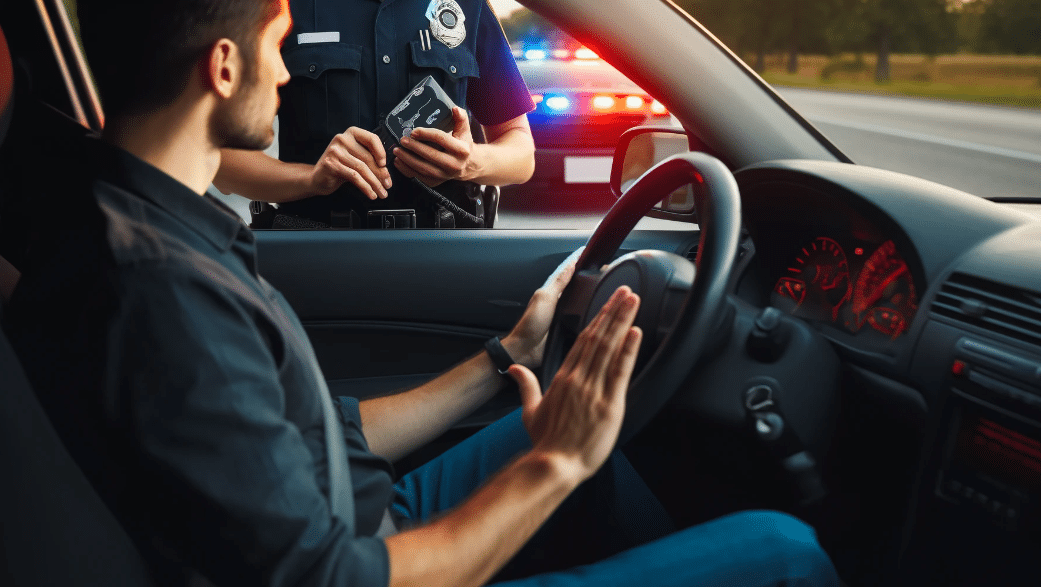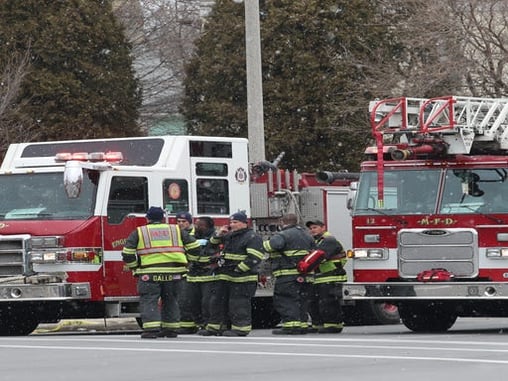Handling a traffic stop, aka pulled over while carrying a firearm, requires calm communication and understanding of the law. Learn essential steps to ensure a safe interaction with law enforcement. Stay informed about your rights and responsibilities to ensure compliance and safety.
Being pulled over while carrying a firearm by law enforcement can be a stressful experience, even for the most law-abiding citizens. Knowing the proper steps to take and understanding your rights and responsibilities can make this situation smoother and safer for everyone involved. This guide provides a detailed roadmap on what to do if you’re pulled over while carrying a firearm.
One of the most important things to remember is this: You aren’t the first person that an officer has pulled over while carrying a firearm, and you won’t be the last. The vast majority of these encounters go off without a hitch, and if the steps below are followed, it’s likely to be a pleasant interaction for all involved.
Table of Contents
Understand Your State Laws
Before you even hit the road, it’s crucial to understand the laws of the state you’re in, as they can vary significantly.
Each state has its own laws regarding concealed and open carry of firearms. Some states require a permit for concealed carry, while others allow it without a permit (constitutional carry). Ensure you know whether you’re legally carrying your firearm in the state you are in or traveling through.
Some states have “duty to inform” laws, which require you to inform a law enforcement officer that you are carrying a firearm as soon as you have an interaction. Other states do not have this requirement. Knowing this law is essential, as failure to comply can result in legal penalties.
Before You’re Pulled Over While Carrying
Preparation and mindset are key factors in handling a situation where you are pulled over while carrying a firearm.
Keep Your Documentation Handy
Always have your driver’s license, vehicle registration, proof of insurance, and carry permit (if required) in an easily accessible location. Fumbling around to find these documents can possibly be interpreted as suspicious behavior.
Adopt a calm mindset whenever you’re driving. If you’re pulled over, take a deep breath and prepare to comply with the officer’s requests. Avoid making sudden movements or acting nervously.
The Traffic Stop: Step-by-Step
When you see the flashing lights of a police car behind you, follow these steps to ensure a smooth interaction.

Pull Over Safely
Find a safe location to pull over, preferably well-lit and away from heavy traffic. Use your turn signal to indicate you’re pulling over.
Turn Off Your Engine and Roll Down Windows
Turn off your engine to show you’re not planning to flee. Roll down your windows, especially the driver’s side, to make communication easier. Additionally, if it’s dark, turning on your dome light can go a long way.
Keep Your Hands Visible
Place your hands on the steering wheel where the officer can see them. This gesture shows you’re not a threat and are willing to cooperate.
Informing the Officer
How you inform the officer about your firearm can set the tone for the entire interaction.
Duty to Inform States
If you’re in a state with a duty to inform law, calmly state that you are a concealed carry permit holder and that you have a firearm in the vehicle. For example, you could say, “Officer, I want to inform you that I have a concealed carry permit and I am carrying a firearm. How would you like to proceed?”
Non-Duty to Inform States
Even if you’re not required to inform the officer, it can still be beneficial to do so. Transparency can help put the officer at ease. However, if you choose not to inform, ensure that your firearm remains concealed and inaccessible during the stop.
Handling Requests for Documentation
The way you handle the request for your documents can further demonstrate your cooperation. It is recommended to already have your documents in your hand, but if that’s not an option, follow the guidelines below for a smooth transition.

Before reaching for any documents, inform the officer of your intentions. For instance, “Officer, my driver’s license and registration are in my glove compartment. I will need to reach for them.”
Move slowly and deliberately when reaching for your documents. Sudden movements can be misinterpreted as a threat.
Responding to Further Questions
Be prepared to answer questions regarding your firearm. While some won’t like it, it could be a part of the traffic stop. It’s usually meant as a safety measure for all involved, and not a personal attack.
Answer the officer’s questions honestly. If they ask where the firearm is, tell them its location. Misleading or lying to an officer can lead to complications and distrust.
Always communicate respectfully. Avoid confrontational language and maintain a polite tone, regardless of the officer’s demeanor.
Handling Different Scenarios
Various scenarios can arise during a traffic stop, whether or not you’re pulled over while carrying, and being prepared for them can help you remain calm and in control.

If Asked to Exit the Vehicle
If the officer asks you to step out of the vehicle, do so calmly. Inform the officer if the firearm will become visible when you exit. Remember if you’re pulled over while carrying, you’ll want to make sure you’re both on the same page.
If the Firearm is Requested
If the officer asks to take possession of your firearm during the stop, comply without argument. Explain how it is secured and follow the officer’s instructions carefully.
Post-Traffic Stop: Know Your Rights
Understanding your rights after the traffic stop is crucial in ensuring your rights are not violated, because after all, things can happen once in a while when you’re pulled over while carrying.
If your firearm is taken by the officer, ask for documentation of the seizure and the process for retrieving it. This rarely happens but if it does, make sure you’re asking the right questions and following up.
If you feel your rights were violated during the stop, file a formal complaint with the police department. Provide detailed information about the incident.
Additional Tips for Safe Interaction
Adopting additional safety measures can further ensure a smooth interaction with law enforcement. Regardless of this topic of being pulled over while carrying, these points should always be practiced.
Practice Situational Awareness
Always be aware of your surroundings when you’re pulled over while carrying, or anytime for that matter. Understanding the environment can help you react appropriately to the officer’s commands.
Stay Informed About Changes in Laws
Laws regarding firearms and traffic stops can change. Stay informed about any updates in your state’s laws to ensure you remain compliant.
Educate Yourself on Firearm Safety
Continually educate yourself on firearm safety and best practices. This not only ensures your safety but also the safety of those around you.
The Importance of Responsible Gun Ownership
Being a responsible gun owner extends beyond knowing how to handle being pulled over while carrying. It involves a commitment to safety, education, and respect for the law.
Safe Storage
Always store your firearm safely, whether at home or in your vehicle. Use a lockbox or a similar secure method to prevent unauthorized access when your firearm is not in use.
Regular Training
Regular training and practice with your firearm are essential. This ensures that you can handle your firearm safely and effectively if the need arises.
Understanding Self-Defense Laws
Understand the self-defense laws in your state. Knowing when and how you can legally use your firearm in self-defense can prevent legal complications.
Final Thoughts
Being pulled over while carrying a firearm requires calm, clear communication and an understanding of your rights and responsibilities. By preparing in advance and knowing how to handle the situation, you can ensure a safer interaction for both you and the law enforcement officer.
Handling a traffic stop while carrying a firearm involves a series of careful steps and considerations. By understanding your state’s laws, preparing your documentation, maintaining a calm demeanor, and communicating effectively with law enforcement, you can navigate the situation smoothly and safely. Additionally, committing to ongoing education and responsible gun ownership practices further ensures your safety and the safety of those around you.
Remember: If you’re ever pulled over while carrying a firearm, don’t freak out. Remain calm, respectful, and follow the simple rules above.
Safety Tip: Always keep your firearm secured and never reach for it unless given permission. Maintain clear communication with law enforcement and follow their instructions to ensure a safe and compliant interaction. Being pulled over while carrying doesn’t need to be stressful!
Legal Disclaimer: The information provided in this article is for educational purposes only and does not constitute legal advice. Laws regarding firearms and concealed carry can vary significantly by state and are subject to change. Always consult with a qualified legal professional or law enforcement agency for advice specific to your situation and to ensure compliance with all applicable laws.















I have been pulled over several times over the years while carrying and I always tell the officer that I am carrying concealed and ask him what he wants me to do. I comply fully with his instructions and have never had a problem. I keep my hands at 10 & 2 on the wheel, speak respectfully, and tell the officer what I am about to do before I do it. Each time I was given a warning and proceeded on with no problems.
My family has debated several times about the drivers responsibility to inform the officer that his passengers may also be legally carrying, that there are other firearms in the vehicle. The debate has been on whether or not the driver should say anything to the officer unless the officer ask if anyone else in the car has a firearm. Some say the officer doesn’t want you to say anything about the other individuals in the car , he’s only speaking to you. That this will only cause the officer to need to check into each and everyone else in the car. My wife claims she was told not to say anything about the passengers to the officer by her CPL instructor, and he was himself an officer of the law. I feel like you should definitely inform the officer. But she won’t let me win this one! I’m Looking for support!
Please help us settle the debate. Thanks